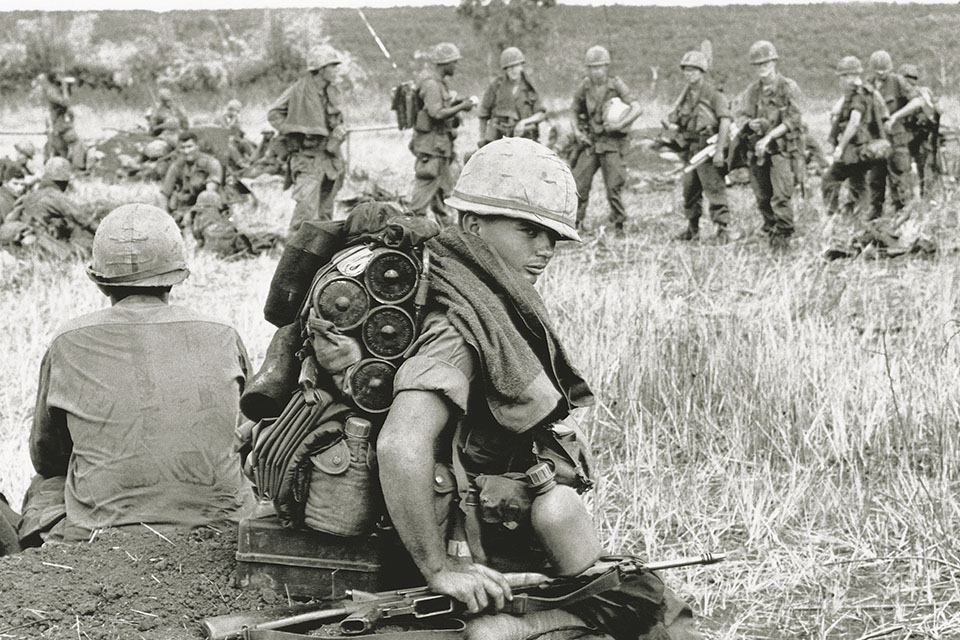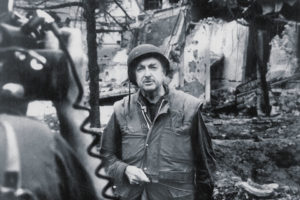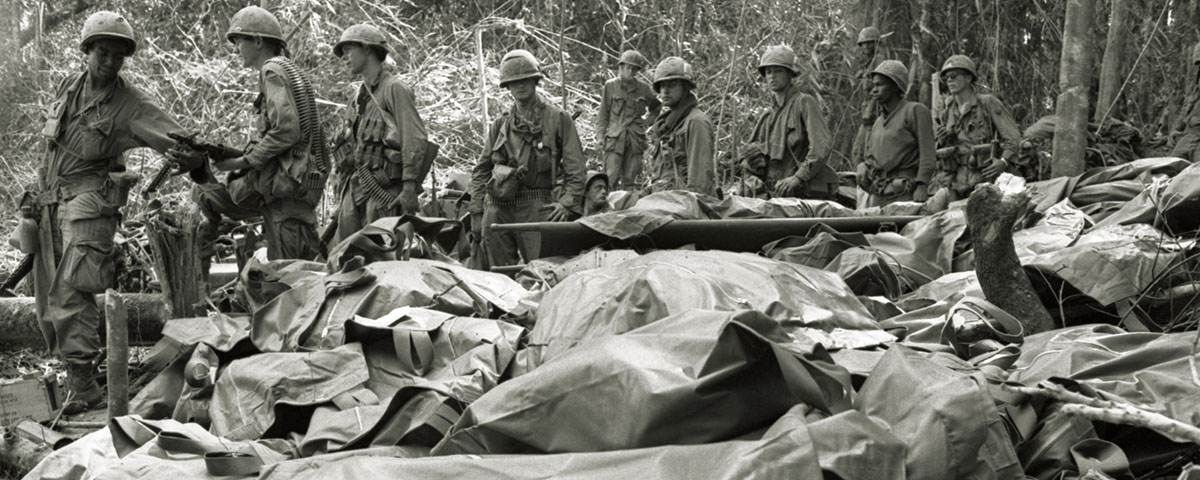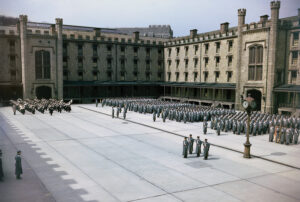In their coverage of the 1968 Tet Offensive, did journalists distort the truth rather than tell it? Look at what they said and wrote.
One of the most momentous events of the Vietnam War, the communists’ 1968 Tet Offensive, is mired in controversy over whether the press inaccurately portrayed a U.S. victory as a defeat and turned the public against the war. There is a widespread belief, fostered by a multitude of articles and books, that the media treated the attacks as a disaster for American and South Vietnamese troops. But those charges against the press are often phrased in generalities that aren’t backed with actual quotes from news reports and don’t reflect the media consensus on the attacks.
The communist forces—mostly Viet Cong, but including substantial numbers of North Vietnamese—were heavily outnumbered and even more heavily outgunned when the offensive began on Jan. 30 and 31, 1968. To have even a chance of victory they would have needed good coordination and near-complete surprise. The demand for surprise prevented them from disseminating their plan widely among their own forces, causing a massive failure of coordination. Still, they achieved a partial surprise. Some American and many South Vietnamese units were poorly prepared or completely unprepared for the offensive, but others were ready for the attackers.
The initial communist attacks came as a terrible shock to the American public and to many journalists who reported on them. The U.S. government and military had been painting for the press and public a picture of communist weakness. Gen. William Westmoreland, in charge of all U.S. combat forces in South Vietnam as head of Military Assistance Command, Vietnam, had been especially conspicuous in pushing claims of progress.
Most of the best reporters in South Vietnam, who talked a lot with officers in the field, recognized that those claims were exaggerated, but higher-ranking journalists in New York and Washington tended to believe the optimistic statements of senior officers and officials. If the anchor of a network news program believed Westmoreland’s claims that the communist forces were weakening, it did little good to have a reporter in the field who knew better.
Hanson W. Baldwin, the hawkish military editor of The New York Times, noticed that the reports of a weakening enemy did not seem to fit the actual performance of communist forces on the battlefield, but he nonetheless chose to believe the reports. His articles on Dec. 3 and Dec. 26, 1967, included statements like, “Two years of attrition have weakened the enemy even though the weakening may appear imperceptible to the veterans of [the bloody November 1967 battle of] Dakto,” and “Most intelligence experts believe that the enemy is weaker than he appears to be.”
Joseph Alsop, whose regular column in The Washington Post gave him an extraordinary degree of influence in Washington and was syndicated to hundreds of newspapers across the country, was so wildly optimistic about the war in 1966 and 1967 that even Westmoreland told the journalist he was going too far. On Oct. 11, 1967, Alsop announced it was “near-certain” that Hanoi was abandoning large-unit warfare in South Vietnam. When the White House leaked to him some early intelligence on what became the Tet Offensive, he watered it down in his analysis: “There have been a couple of indications of quite important enemy units grimly preparing to make one last assault, while thinking about defecting in mass if the assault should fail.”
First Reactions
The American media did not portray the Tet Offensive as a communist military victory. That is myth. But the shock of the offensive led many journalists quickly to conclude that the communists had won a political victory by showing that they had the ability to attack cities and towns throughout South Vietnam. The military coverage during February 1968 mostly focused on the details of the ongoing struggle, and few journalists chose to designate an overall winner or loser in the military confrontation while the combat was still raging. Those who did pick a losing side at an early date tended to pick the communists. Alsop wrote on Feb. 19 that the communists’ attack on the cities had been “on balance a disaster” for them.
Charges that the American media gave too much attention to the Viet Cong attack on the U.S. Embassy in Saigon are quite correct. The attackers, a small group of special assault troops (called sappers), were all killed or captured in about six hours and did not seriously damage the embassy. But it is unlikely that the media’s exaggerated focus on this incident had a negative impact on public support for the war. The concentrated coverage of events in Saigon distracted attention from the way stronger communist forces were inflicting serious losses in other battles lasting much longer. It made the Tet Offensive seem smaller and less dangerous than it actually had been.
CBS News anchor Walter Cronkite, after interviewing Westmoreland in Saigon on Feb. 13, said in a filmed report broadcast on the CBS Evening News the following night: “First, and simplest, the Vietcong suffered a military defeat. Its missions proved suicidal. If they intended to stay in the cities as a negotiating point, they failed at that. The [South] Vietnamese Army reacted better than even its most ardent supporters had anticipated.” That account of Tet was not dramatically out of line with what other journalists were reporting on network news shows and in major print publications, so it did not attract much attention.
Cronkite’s view changed after he spent more than a week in South Vietnam, talking with American officers and seeing for himself in Hue that the communist forces there were much stronger than Westmoreland had told him they were.
On his return to New York, Cronkite put together a 30-minute CBS News special report on Vietnam that aired on Feb. 27. That was almost a month into the communist offensive, but heavy fighting was still taking place in many parts of South Vietnam. During the week of the broadcast, 542 Americans were killed in action in Vietnam. The highest number for any week of the war up to that point had been 543 for Feb. 11-17.
In his commentary at the end of this broadcast Cronkite said he believed the offensive could not be described as a victory or defeat for either side but rather as a “draw,” a “standoff” and he concluded that the United States seemed “mired in stalemate.”
A few minutes earlier, however, he had seemed to call Tet a communist defeat. He said the Tet attacks had been the second phase of a three-phase plan. The first phase, attacks on Dak To and Loc Ninh in late 1967, had failed. The second-phase attacks, against cities all across South Vietnam during the Tet holiday celebrating the Lunar New Year, “also have failed,” though they inflicted great damage, Cronkite said, and added, “Now it’s believed the enemy is ready to move to phase three of the winter-spring offensive with the hope that he can recoup there what he lost in the first two phases.” Just a few days later Cronkite indicated the communists’ hopes for the third phase were not realistic. In his Evening News broadcast on March 4, he stated, “It seems fairly clear to any observer in Vietnam that the communists cannot win this offensive on the battlefield.”
Cronkite had not called the Tet Offensive a communist victory, yet his Feb. 27 broadcast is widely remembered as being shockingly negative, perhaps because his comments about a military draw and stalemate looked negative at a time when the public was more accustomed to hearing Tet and other communist offensives described as military defeats for the enemy.
Even the most anti-war statements in the media seldom were more negative than Cronkite’s judgment that the Tet Offensive had been a draw. On March 11, the Times editorialized against a proposal to send more American troops to Vietnam. It strongly denounced the notion that there might be “light at the end of the tunnel” and proclaimed: “The tunnel has turned out to be a bottomless pit, going down toward nowhere…. The time has come to abandon this bankrupt policy.” But the editorial did not say that the bankrupt policy had led to defeat, only that the enemy had been able to match past expansions of American forces and thus “each escalation has produced a new stand-off.”

Follow-up Reporting
Communist forces did not fade back into the jungle to lick their wounds in the weeks and months after Tet. Combat was continually heavy until late June and intermittently heavy until the end of September. By that time the communists had been seriously weakened by their cumulative losses and desperately needed a respite. Americans and South Vietnamese on offensive operations did not find serious combat nearly as often in the last quarter of 1968 as they had up to that time. An accelerated pacification campaign—providing rural areas with civic improvements and increased security to weaken the Viet Cong’s influence—encountered less resistance and restored the South Vietnamese government’s control in many villages that had been lost in the first half of the year.
By the beginning of 1969, American reporters in Vietnam were hearing from officers in the field, whom they trusted much more than they did government spokesmen, that the enemy really had been seriously weakened. On Jan. 3, Charles Mohr wrote in the Times:
“The indigenous South Vietnamese Vietcong military and political leadership lost a large part of its best leadership in the 1968 general offensive, which began at the Lunar New Year…. Although less important than the loss in leaders, the rank and file of Vietcong guerrillas and infiltrated North Vietnamese soldiers suffered very heavily in their bold attacks on cities.”
Some of the senior journalists based in New York and Washington accepted the new optimism, but others did not. A Times editorial on Jan. 17 denounced American generals, “perennial optimists,” who “continue to promote delusive dreams of military victory…. Such talk has been heard before—notably, just before last year’s devastating Tet offensive.”
1969: Another Tet to Cover
A new communist offensive hit on Feb. 23, 1969, immediately after that year’s Tet celebration. It was not as big as the 1968 Tet Offensive, nor did it last as long, but the casualty numbers were substantial. American combat deaths for the week ending March 1 totaled 453, not far short of the highest weekly toll for the 1968 offensive (the 543 deaths for the week ending Feb. 17).
Combat in 1967 had killed about 180 Americans per week. Tet 1968 began a period of continuously very heavy combat that lasted 21 weeks and killed an average of 403 Americans per week from Jan. 28 to June 22. Tet 1969 started 18 weeks of intermittently heavy combat, which killed an average of 275 Americans per week from Feb. 23 to June 28.
One would think that the heavy casualties would have made the ’69 offensive also a memorable event, but it has been almost completely forgotten. The main reason is that the press did not treat it as a crisis. The press had treated Tet ’68 as a crisis because it obviously was one. The American military was unable to persuade President Lyndon B. Johnson in 1968 to send massive reinforcements of more than 200,000 troops to Vietnam, but he felt he had no choice but to send a significant number—initially 17,000 men, then an additional 22,000. The press gave extensive coverage to controversies about the size of the reinforcement package.
A year later, when the press contemplated possible American responses to Tet ’69, the question of significant reinforcements did not even arise. It seemed obvious that the American forces already in South Vietnam were adequate to cope with the offensive. The press treated the offensive not as a crisis but merely as a provocation. The question in 1969 was whether President Richard Nixon should or would respond to that provocation by resuming the bombing of North Vietnam, ended by Johnson late in 1968.
MACV treated the prospect of an offensive much more seriously in February 1969 than it had in January 1968, even though the actual threat was smaller. Perhaps most important in shaping press and public reactions was the large and successful effort that MACV and the South Vietnamese government made to ensure that there would be no serious fighting in Saigon. The defenses there were much stronger and the troops much more seriously on alert for Tet ’69 than for Tet ’68.
As early as Jan. 4, 1969, the Times had reported: “Security measures have been increased recently throughout Saigon and other South Vietnamese cities in reaction to speculation that the enemy may be planning another major offensive….This afternoon, South Vietnamese military engineers were stringing barbed wire around the approaches to a bridge deep within Saigon’s residential areas. Previously, a single guard had provided security….No one has forgotten the Tet offensive in late January and February of 1968…. As 1969 begins, most of the 100,000 or so enemy troops in South Vietnam are within striking distance of either Saigon, Danang or Hue.”
The communists managed to fire rockets into Saigon from miles away during the 1969 offensive, but they could not march whole battalions into the city, as they had during the night of Jan. 30-31, 1968.
Mohr complained in the Times on Feb. 24 and March 13 that military spokesmen sometimes tried to make the situation look better than it actually was, but this did not become a major issue because MACV’s optimism was not nearly as extravagant in 1969 as it had been in the months before Tet ’68.
Terence Smith in Saigon spoke with senior officers at MACV on Feb. 27 and wrote in the Times the following day: “The five-day-old enemy campaign of shelling and ground attacks flagged today, but few members of the United States Command took much comfort from the lull….No one here doubts the enemy’s capability to mount a full offensive. There are about 40,000 to 50,000 enemy troops west of Saigon, including some 15,000 within easy striking distance of the capital.”
Gen. Creighton Abrams, who replaced Westmoreland as MACV commander in mid-1968, had managed to win back some of the credibility for claims of progress that Westmoreland had thrown away.
The editorial writers at the Post—who saw no chance that the United States could actually win the war and felt that any success on the ground should simply
be used to put the United States in a better negotiating position during peace talks—were prepared to accept that progress might indeed be occurring on the ground. They did not treat the current offensive as evidence for a lack of progress.
On Feb. 28, six days into the 1969 offensive, the lead editorial in the Post stated: “Optimism over progress on the ground in South Vietnam is nothing new. It has been with us in good times and bad, a light that always beckoned at the end of an increasingly long and dark tunnel. . . . There had been optimism from John F. Kennedy in 1963, from General Maxwell Taylor in 1964, from [Defense Secretary] Robert McNamara in 1965, [Ambassador to South Vietnam] Henry Cabot Lodge in 1966, General William Westmoreland in 1967, and [head of pacification] Robert Komer in 1968. These were the men in charge, but their predictions were not believed: not by the press, and ultimately not by the public. Too many of the predictions had been wrong. Since, 1963, the record of the skeptics and the pessimists has been excellent. Now, . . . there is optimism again. . . . But it is optimism which, for a change, must be taken seriously—perhaps even believed.”
One cannot imagine such a statement appearing six days into the 1968 offensive.

The Press and Public Opinion
The impact of the 1968 Tet Offensive on public opinion has often been overrated. In early November 1965, just before fighting in South Vietnam’s Ia Drang Valley brought the first substantial death tally, a Gallup poll found that 64 percent of the public thought the decision to send the military to Vietnam was a correct one, and just 21 percent thought it was a mistake.
By May 1971, as the U.S. combat presence was finally winding down, the war had become deeply unpopular and the original decision was supported by just 28 percent—a drop of 36 points from 1965. Meanwhile, 61 percent had come to believe it was a mistake.
The January 1968 Tet Offensive caused just a small portion of that overall decline in support for the war, despite negative press coverage and a dramatic increase in U.S. casualties. Big drop-offs had already occurred by December 1967, when support for the war stood at 46 percent, down 18 points from the 1965 poll. The number who thought the war was a mistake rose to 45 percent.
In late February 1968, shortly after the attacks, support for the war dropped only 5 points below the December 1967 number, to 41 percent. The number who thought the war was a mistake didn’t change much either, rising 4 points since December to 49 percent. But that poll did mark an important shift in public opinion. Significantly more people thought the war was a mistake than believed it was correct—a tipping point in what was politically possible as the Johnson administration responded to the Tet attacks.
Although Johnson could still send more troops to South Vietnam and increase monthly bomb tonnages on Indochina, he could not run for president while doing so, or talk too openly about it. When he announced on March 31 that he was not running in the 1968 election, Johnson falsely said that he was “reducing—substantially reducing—the present level of hostilities,” because he realized that was what much of the public wanted to hear.
By August 1968, with the casualty count still high, a majority of Americans, 53 percent, for the first time thought the war had been a mistake.
The renewal of heavy combat after the February 1969 Tet attacks pushed public support for the war down to a level that forced Nixon to de-escalate. The monthly bomb tonnage dropped on Indochina peaked in March 1969. The number of American military personnel in Vietnam peaked in April at about 543,000 The first substantial declines, in both figures, were in August.
All American troops were out of Vietnam by the end of March 1973. The North Vietnamese achieved their 1968 Tet Offensive goals in April 1975, when the South Vietnamese government in Saigon surrendered.
Edwin E. Moïse, a professor of history at Clemson University, is the author of The Myths of Tet: The Most Misunderstood Event of the Vietnam War, and Tonkin Gulf and the Escalation of the Vietnam War (revised edition forthcoming).





